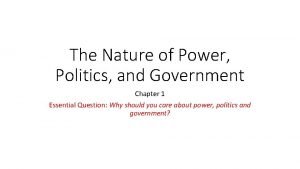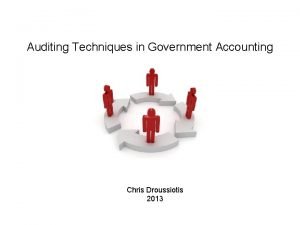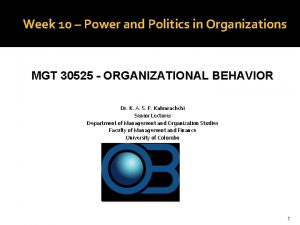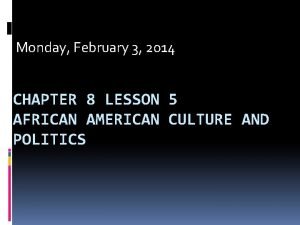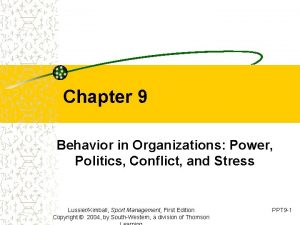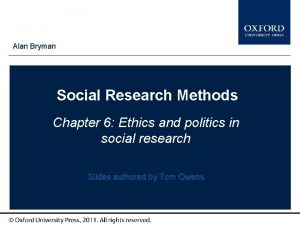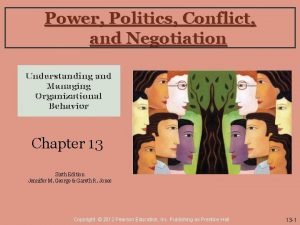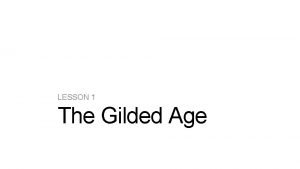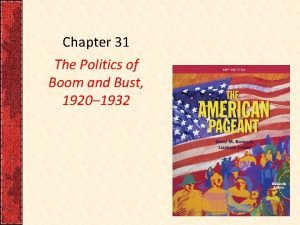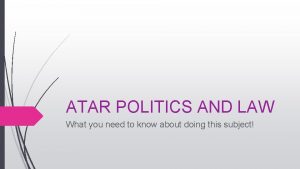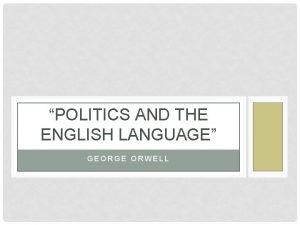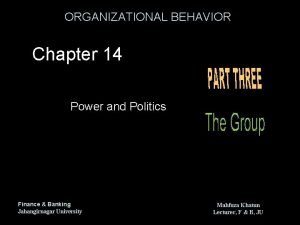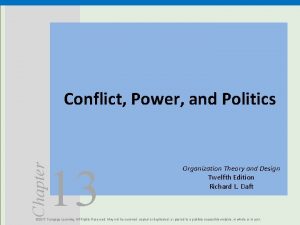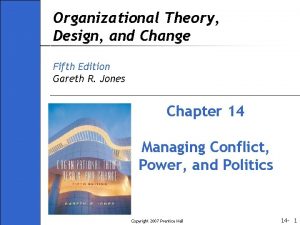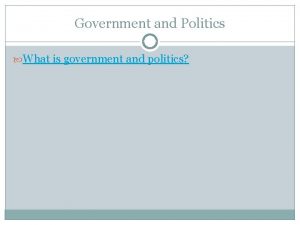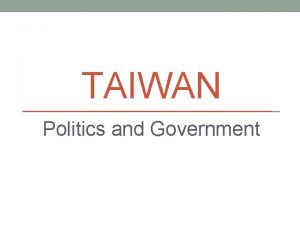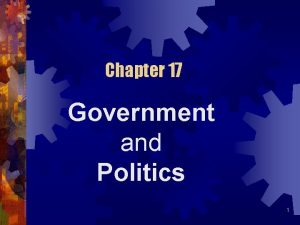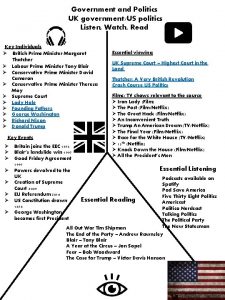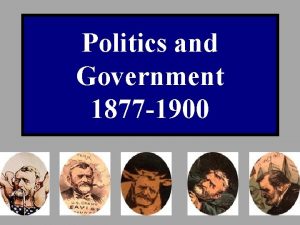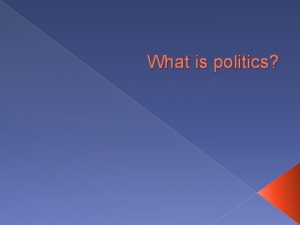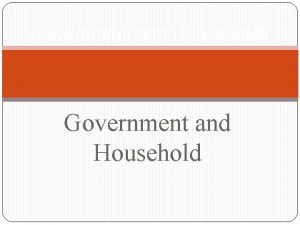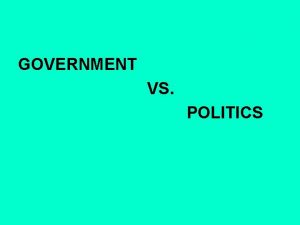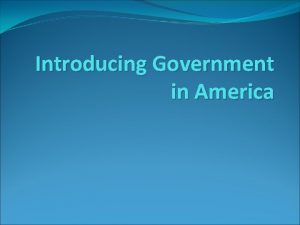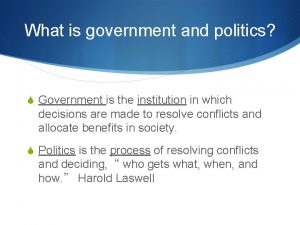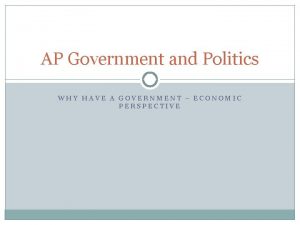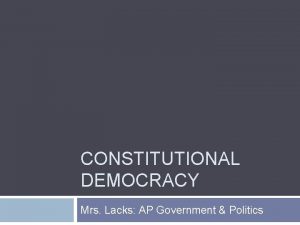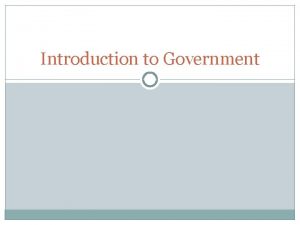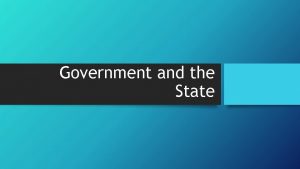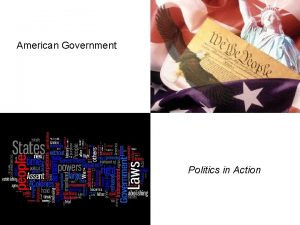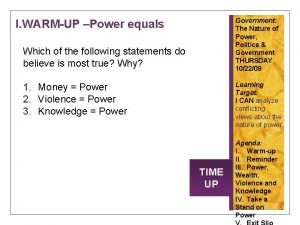Ch 17 Politics and Government Politics Overview A





























- Slides: 29

Ch. 17 Politics and Government

Politics: Overview A social institution that distributes power, sets a society’s goals, and makes decisions l Power: the ability to achieve desired ends despite resistance from others l Government: a formal organization that directs the political life of a society l Authority: power that people perceive as legitimate rather than coercive

Authority (Max Weber) l Traditional: power legitimized through respect for long-established cultural patterns, e. g. , a monarchy l Rational-legal: power legitimized by legally enacted rules and regulations, e. g. , lawful government l Charismatic: power legitimized through extraordinary personal abilities that inspire devotion and obedience ¡ Read: The Anatomy of Charisma

Types of Political Systems l Monarchy: a single family rules over generations ¡Constitutional vs. Absolute Monarchy l Democracy: power is exercised by people as a whole ¡Limited by bureaucracy and economic inequality in society l Capitalist approach to political freedom is personal liberty and l Socialist approach is that economy meets basic needs

Political Systems (cont. ) l Authoritarianism: denies popular participation in government l Totalitarianism: a highly centralized political system that extensively regulates people’s lives l A Global System? ¡ United Nations ¡ Non-Governmental Organizations (NGO): advance global issues, such as human rights and environment ¡ Other ideas?

Politics in Canada ¡Individualism is tempered with a sense of communal responsibility ¡Shown by Canadian Charter of Rights and Freedoms (click link for Guide to Charter) ¡A larger budget for government services than the U. S. ¡Continuing debate about how much should government do and how much it should tax

Canada’s Political Parties Organizations operating within the political system that seek control of the government l Federal level, 3 main national parties (Liberals, Conservatives, and NDP) and a regional one (Bloc Québécois). l Functions 1. 2. 3. 4. 5. Promote political pluralism Increase political involvement Select candidates Forge political alliances Maintain political stability

Canadian Government

How the Government of Canada Works l According to The Guide to the Canadian House of Commons (https: //lop. parl. ca/About/Parliament/Guide. To. Ho. C/index-e. htm): l Canada's Parliament consists of three parts: the Queen, the Senate and the House of Commons. They work together to make the laws for our country. The executive branch consists of the Queen, the Prime Minister and Cabinet, and the departments of government. They implement the laws. The legislative branch makes the laws, and the judicial branch — which is not part of Parliament — interprets them.

How the Government Works… (all information on slides 10 – 14 taken directly from : https: //lop. parl. ca/About/Parliament/Guide. To. Ho. C/index-e. htm) l The Queen l Canada is a constitutional monarchy. This means that the laws governing Canada recognize the Queen as the formal Head of State. All federal laws are made in the Queen's name. She also performs many important ceremonial duties when visiting Canada.

The Governor General l The Governor General is the Queen's representative in Canada. The Queen appoints the Governor General on the advice of the Prime Minister. The Governor General usually serves for five years. One of the most important roles of the Governor General is to ensure that Canada always has a Prime Minister. For example, if no party had a clear majority after an election, or if the Prime Minister were to die in office, the Governor General would have to choose a successor. l The Governor General acts on the advice of the Prime Minister and Cabinet. The duties of the Governor General include: summoning, opening and ending sessions of Parliament; reading the Speech from the Throne; giving Royal Assent to bills; signing state documents; and dissolving Parliament for an election.

The Senate l The Senate studies, amends and either rejects or approves bills passed by the House of Commons. It can also introduce its own bills, except those to spend public money or impose taxes, which must be introduced in the House of Commons. No bill can become law until it has been passed by the Senate. Senators also study major social, legal and economic issues through their committee work. l One of the duties of the Senate is to represent the interests of Canada's regions, provinces, territories and minority groups. Seats in the Senate are distributed to give each major region of the country equal representation. l The Senate has 105 members. Senators are appointed by the Governor General on the recommendation of the Prime Minister and hold office until age 75.

The House of Commons l Many laws in Canada first begin as bills in the House of Commons. In the Commons Chamber, Members devote most of their time to debating and voting on bills. The Chamber is also a place where Members represent constituents' views, discuss national issues and call on the government to explain its actions. l To become a Member of Parliament, you must first run in a federal election, which is held every four years. In each of the country's 338 constituencies, or ridings, the candidate who gets the most votes is elected to the House of Commons, even if he or she gets less than half of the total votes. l Seats in the House of Commons are distributed roughly in proportion to the population of each province and territory. In general, the more people in a province or territory, the more Members it has in the House of Commons. Every province or territory must have at least as many Members in the Commons as it has in the Senate.

The Legislative Branch l The legislative branch makes the laws, and the judicial branch — which is not part of Parliament — interprets them.

Political Ideology Spectrum runs from communism (left) to extreme conservatism (right) Left: Anti-big business, egalitarian, collectivist, and interventionist: supports a broad safety net Right: Pro-big business, private enterprise, and free markets: supports deficit reduction and globalization


Where do you stand? l Go to The Political Compass at https: //www. politicalcompass. org/ l The continuum shown on the previous slide is essentially an economic one. The Political Compass adds another dimension: the social one to help you see where you stand politically. l Take the test , save or printout your “certificate” showing your position and comment on the analysis during the tutorial this week.

Political Participation l Are Canadians cynical about politics? l In the past, voter turnout for federal elections was over 70% l In 2008, turnout fell to a low of 58. 8%. It went up slightly in 2011 to 61. 4%, but rose sharply to 68. 5, in 2015, the year Trudeau was elected as Prime Minister. l Turnout for the 18 -24 age group rose sharply in 2015 to 57. 1% (up from 38. 8% in 2011) l U. S. turnout is generally lower – 61. 4% in 2016 l Only 26% of federal politicians are women l Female representation has not improved much ¡ Lack of financing, contacts ¡ Lack of exemplars, socialization ¡ Commute to Ottawa

Theoretical Analysis of Politics l Pluralist model: Power is dispersed among many competing interests groups, but powerful and wealthy elites are integrated ¡Structural finctionalist model l The power-elite model: “Real” power is concentrated among the very rich: Can the wealthiest ever encounter pressure to not act in their own best interests? ¡Social conflict model

Theoretical Analysis of Politics l Marxist model explains politics in terms of a society’s economic system: Power is divided along the lines of a capitalist economy. The majority are excluded, like majority of workers ¡Not a true communist model as Marx envisioned it. In Canada: Canadians can participate and vote, but the system is much less democratic than people think (for instance, for leadership of Ontario PC’s, although Christine Elliot won the majority of the votes, Doug Ford declared winner of leadership race. )

War l War = the pattern of large groups of people methodically trying to kill one another l armed conflict between two countries or groups within a country l includes undeclared battles, civil conflicts, guerrilla wars, covert operations, terrorism l relies on collective violence as opposed to interpersonal violence

War l Societal warfare has replaced interstate war l Risk of war varies by: ¡Type of government (democratic, authoritarian, or intermediate) ¡Level of prosperity l Democracies and autocracies have lower risk of war, but states with transitional intermediate governments have higher risk because of lack of stable government system and policies ie Iraq, Afghanistan

Other Factors Related to War l In authoritarian states: ¡a secondary consequence of a military-state connection ¡is designed to engender patriotism and to justify penalizing political dissidents. l Decentralized leadership less likely to be warlike than is centralized leadership l U. S. at risk?

Other factors l Ideologies and religion also influence politics and war l Politics occur between states l World system theory (Wallerstein) and unequal relations between core and peripheral nations l Advances in military technology ¡Technology has made warfare more lethal Human consequences Ecological consequences

Power Beyond the Rules l Revolution: the overthrow of one political system to establish another occurs with these traits: ¡Rising expectations ¡Unresponsive government ¡Radical leadership by intellectuals and students ¡Establishing a new legitimacy, often difficult if deposed leaders are strong

Power Beyond (cont. ) Terrorism: Acts of violence, or the threat of violence, employed as a political strategy by an individual or group 1. Intent is to undermine legitimate political authority 2. Roots of terrorism often found in religious, ethnic nationalist, political, economic, and social differences 3. Used by governments as well as individuals State Terrorism – use of violence by government officials, e. g. , in Argentina ~30, 000 people disappeared under military rule in the 1980’s 4. Democratic countries are especially vulnerable to terrorism because of civil liberties

The Battle for Economic and Political Equality: The Take l The Take: Occupy, Resist, Produce! (2004) ¡Documentary by Avi Lewis and Naomi Klein ¡Documents the workers’ revolution: the “National Movement for Recovered Factories” in Argentina ¡After a 2001 economic collapse in Argentina, the factory owners fled. Unemployment rose to 20%. ¡ Worker co-operatives fought back, took over abandoned factories and re-started production. ¡Although the “Occupy” Movement in N. America ultimately failed, in Argentina, by 2013, more than 300 employee-run factories in Argentina and has spread to other global locations (ie in Venezuela, India, Italy) ¡Read Here’s the Chocolate Factory (Guardian 2011) and Occupy Buenos Aires: the workers' movement that transformed a city, and inspired the world (2016)

Fighting for Participatory Democracy: The Occupy Movement (2011) l A political movement that started in Lower Manhattan in New York and spread to become a global protest against financial/social inequality l Slogan: "We are the 99%" l Poor organization and leadership of the shortlived movement lead to its eventual failure l But spawned other movements (ie Black Lives Matter, Arab Spring Uprising) l In 2016, “Take on Wall Street” new movement focused on limiting financial sector power over the political process and the economy

Naomi Klein and The Shock Doctrine l Naomi Klein: Canadian social activist, journalist and documentary filmmaker (No Logo, This Changes Everything, Shock Doctrine, The Take) l Naomi Klein: How to Resist Trump's Shock Doctrine (The Intercept, 2017) ¡“I noticed a brutal and recurring tactic by right wing governments. After a shocking event – a war, coup, terrorist attack, market crash or natural disaster – exploit the public’s disorientation. Suspend democracy. Push through radical “free market” policies that enrich the 1 percent at the expense of the poor and middle class” (Klein, 2017) l See Klein’s 2017 book No Is Not Enough: Resisting Trump’s Shock Politics and Winning the World We Need
 Whose government politics populists and progressives
Whose government politics populists and progressives Unit 1 government study guide
Unit 1 government study guide The nature of power politics and government
The nature of power politics and government Overview of government accounting
Overview of government accounting State and federal constitutions
State and federal constitutions Power and politics in organizations
Power and politics in organizations Media information opportunities
Media information opportunities Chapter 8 lesson 5 african american culture and politics
Chapter 8 lesson 5 african american culture and politics Bureaucracy and politics in india
Bureaucracy and politics in india Power politics and conflict in organizations
Power politics and conflict in organizations Ethics and politics in social research bryman
Ethics and politics in social research bryman Power, politics and conflict in organizations
Power, politics and conflict in organizations Philosophy, politics and economics michael munger
Philosophy, politics and economics michael munger Lesson 1 politics and the gilded age
Lesson 1 politics and the gilded age Chapter 31 the politics of boom and bust
Chapter 31 the politics of boom and bust Polis bsc
Polis bsc Politics and law atar
Politics and law atar Relationship between sport and politics
Relationship between sport and politics Politics and the english language
Politics and the english language Preferred power tactics by influence direction
Preferred power tactics by influence direction Power and politics organization theory
Power and politics organization theory Power and politics
Power and politics Virusmax
Virusmax Data cleaning problems and current approaches
Data cleaning problems and current approaches Carbon family
Carbon family An overview of data warehousing and olap technology
An overview of data warehousing and olap technology What is bioinformatics an introduction and overview
What is bioinformatics an introduction and overview An overview of data warehousing and olap technology
An overview of data warehousing and olap technology Data quality and data cleaning an overview
Data quality and data cleaning an overview Data quality and data cleaning an overview
Data quality and data cleaning an overview


